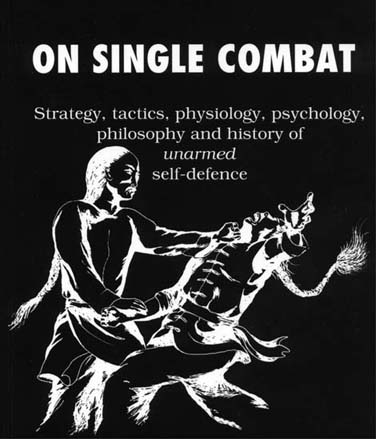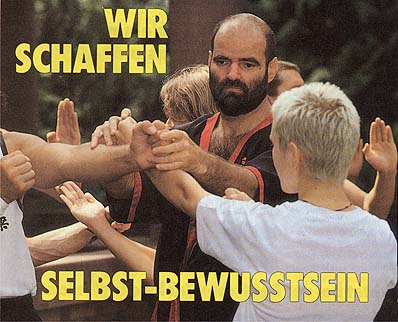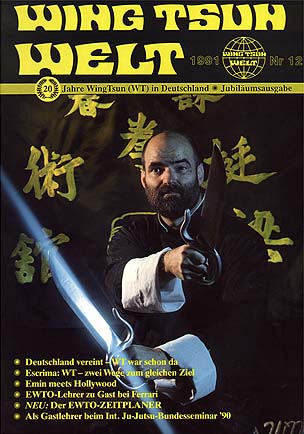On Single Combat
by Keith R. Kernspecht
9th Degree WT, Master of Arrival (MOA)
Foreword
It's a great pleasure for me to be writing the preface to this book, On Single Combat, for many reasons not least of those being that the author is a man that I admire very much. But being a nice person, even a great martial artist, who Keith undoubtedly is, is in itself not enough to warrant me to put my name to a book about my life's quest, the martial arts. For me to make comment and /or endorse it, a book really has to impress me. This did far more, it enlightened me.
At first glance you may mistakenly see On Single Combat as being 'simply about Wing Chun or WingTsun (WT)', as Grandmaster Leung Ting's system is spelled, after all the author is recognised as a world renowned master of the art, but the contents cover so much ground that you cannot confine it to one style, it all styles and yet, paradoxically, it is no style. It is all encompassing and in my opinion one of the most comprehensive books on combat on the market today.
I first met Keith in London, 1997, where we spent a day talking about the martial arts and exchanging ideas. It was obvious after only a few minutes that we were very similar in our martial arts background and experiences, I felt an immediate affinity and deep respect for him.
This may seem odd coming from a former night club bouncer whose base system is Shotokan Karate, on the face of it, Keith and I may seem poles apart, and yet, in actuality we parley the same speak, our thoughts and views run alongside each other and our belief system seems inseparable alike.
How can this be? Perhaps it is because we have both tasted, ney dined upon the bitter taste of adversity, suffering, en route, the punishing blows of the boxer, the mauling cranks of the grappler and cripple shooting pain of the kicker in our bid to find a 'way' that best suited us. We have also faced down the street fighter and suffered the mental torment of fighting our greatest adversary - ourselves. Because of this courtship with hardship we both now understand ourselves which, as General Sun Tzu said some 25 centuries ago, allows us to face 100 battles without fear of defeat.
Another important lesson we both uncovered on our bloody and epic journey was the absolute futility of violence and that a physical response should only be employed when no other option is available. There is a great responsibility that comes with being a highly trained martial artist. When you reach an elevated level of competence, you no longer worry about being hurt in affray, rather you agonise about hurting, even killing an opponent who is perhaps needed a point in the right direction as opposed to a poke in the throat. Therefore, at the master level, the art evolves into one of self-control and not one of self-defense. You transcend the need to control others and concentrate instead on the lofty and more worthy task of controlling yourself. Your training evolves to an internal and intangible level where you kick, box and wrestle with the demons of your own mind and dark energies of the world. When you enter this arena, a commendable task I have to say and not one for the faint of heart, you develop an aura that stands apart from others.
When I first met Keith I was not greeted with the concrete hand shake of a man still working on a physical plain, neither did I descry the unapproachable gait of the unsure, rather I found a gentle, confident man, with a kind smile, a welcoming persona and the aura of a fighter.
Napolean Bonaparte said that the sight of the battle field after the fight is enough to inspire princes with a love of peace and a horror of war. Keith and I have seen that battle field and felt that inspiration. They say that there are many paths to the top of the mountain but from the peak, the view is the same, that's why Keith and I have such an affinity and the reason why a venerable Shotokan man is writing the preface of a book for an esteemed WingTsun (WT)-man.
It is my belief that the two most important thing in life are love and knowledge, this author and his book On Single Combat have both in abundance and I highly endorse them to anyone with self-protection and/or self-development, on the physical, mental or spiritual plain - in mind.
This book speaks so much sense that everyone should read it and prepare themselves for reality. Whether you are a novice or an expert, a man or a woman, a layman or a Lord, no matter what your style, colour, creed or disposition there is something in this book for you. It could at some time prove life saving.
Highly recommended, the best book of its kind on the market today!
Geoff Thompson
(July 1997, Coventry, England)(Author of the works "Watch my Back", "Bouncer", "On the Door", etc.)

This book is a distillation of nearly 40 years of martial arts experience. At the end of the 50s, the author began to study various western and eastern martial arts including freestyle wrestling, pro-wrestling, Jiu-Jitsu, Kempo and Shaolin Kung Fu. These were followed by Shotokan and Wado-Karate, Kobudo (weapons), Tae-Kwon-Do, Aikido, the Thai martial arts, Escrima (Philippine stick and knife-fighting), Bruce Lee's non-classical Kung Fu and the Leung Ting system of WT, which experts consider to be the most practical and effective self-defense system of all.

Today Professor Keith R.Kernspecht (National Sports Academy and State University of Bulgaria) is one of the two most highly graded WT-masters in the world, the WT-Chief Instructor for Europe and Co-ordinator for the Western World. He has established the Leung Ting-System of WingTsun in all European countries on behalf of the IWTA in Hong Kong. With a total of more than 1,500 associated schools in Germany, Austria and Switzerland alone, the EWTO, the Western section of the IWTA founded and led by the author, is the world's largest professional martial arts association. Since 1982 the association has published its own magazine, "WingTsun Welt".
"On Single Combat" is the 9th specialist book on the martial arts to be written or published by Keith R. Kernspecht. It is probably the very first comprehensive treatise on the phenomenon of individual combat, including aspects such as strategy, tactics, psychology, physiology, law, history and philosophy, and undertakes to show the complex processes occurring in a combat situation dictate the reactions of a defender and therefore circumscribe his actions. Only very few books concern themselves with the theory and concept behind a style, or with fighting skill pre se. Reversing the definition by Clausewitz which states that war is an extension of individual combat, the author attempts to view individual combat as an element of war and examine whether both are subject to common laws. Further parallels are drawn from the Asian philosophies, chess, tennis and team games such as football and rugby. The knowledge and experiences of highly-successful wrestlers, boxers, karateka, special police units and notorious streetfighters are compared with his own 40-year experience as a martial artist, powerlifter, police officer, university-professor, bodyguard and visiting instructor to international elite police units such as the FBI's Hostage Rescue Team (USA), SEK and GSG9 (Germany), RAID (France), NOCS (Italy), SEK Cantonal Police, Zurich (Switzerland) and GIP (Luxemborg).
The author takes a critical look at the real combat value of the conventional martial arts and self-defense methods, and is not afraid to slaughter a few sacred cows in the process.

Contents
· The weaknesses of the traditional styles. And why the user of such methods can nevertheless occasionally be successful. · Less is more. The best method of self-defence is the one which is able to cope with the most attacks using the least number of movements. · Suicidal knife-attack tricks, useless rigid blocks.
· The weaknesses of the traditional defences. · Comparison between the defence in Boxing and in Budo. · Bruce lee on how easily the eye can be deceived and Wu-wei. · The 10 characteristics of an ideal self defence system.
· The 4 times in self-defence. · The pure defence. · The defence followed by a counter attack. · Attacking rather than defending · The author's choice: The aggressive defence. · Moral and legal considerations. · The long, medium and short distances.
· How to safely cross the borderline. · The universal-technique against all attacks. · Comparison between the WT-Punch and the typical Budo punch.
· Why hand technique before foot technique? · How to get your full bodyweight behind a punch. · Jack Dempsey, Bruce Lee and WT and the "Falling Step"
· The forgotten power line. The secret WT shares with long Greek pancratiasts , Roman gladiators, medieval European "hand fencers", Philippine escrimadores, Thai Ling-Lam fighters, as well as American boxing champs like Jack Dempsey James Corbett and Bob Fitzsimmons ? · Why you must aim and hit with the ring-finger. · The roundhouse punch a suicidal technique for fools?
· Chain punches - have traditional styles no way to cope with them? · The dangerous wrestling attacks. Is wrestling superior to boxing and kicking attacks?
· Steve Arnteil, 8th dan Oyama-Karate, Teruo Kona, 8th dan Wado-Karate, A. Pfluger, 6th Don Shotokan-Karate, on the problems of Karate-defences. · Why WT works. · The Wedge-theory. · All WT fighting principles explained. Lots of examples. · The WT-reflexes the two reaction groups · Everything you need to know about Bong-, Tan-, Pak-, Cham-, Kau-Sao. · Why the WT reflex is faster.
· Why a layman can sometimes be mare dangerous than a blackbelt. · Active and passive shifting/turns, foot-work. · The anti-locking-system · The redundant system (a threefold safety system as standard, ex factory and at no extra cost). · possible combinations and counters · Total combat in 5 phases. · Economy of movement. · How to fight multiple attackers? · The deadly sins in WingTsun · Self-defence by women for women against men.
· #1 Free yourself of your own force! · #2. Free yourself of the force of your opponent · #3. Use your opponent's force against him! · #4 Add your own force to that of your opponent! · When to begin with a specific powertraining for self-defence?
· Internal and external forces.
· Fighting Spirit - the unknown quantity. · Why the better technician often loses against a hell-for-leather type with more fighting instinct? · How to overcome the opponent's fighting spirit. · Dirty tricks and psychological warfare in streetfighting
· How to fight the adrenaline monster. What philosophies can do for us in the martial arts. · Tsun Yang (doctrine of the mean) - Grandmaster Yip Man's own philosophy. · The best and at the same time the worst teaching-method. · The four rafts in WingTsun. · The three stage teaching structure: form, chi-sao, sparring. · WT - a different world. · Major differences between WT and conventional styles: 4 big tables · Short information on WT. · The history of WT and martial arts in general.
· Cheating with Chi-power. · How to achieve softness. · Dim-Mak the delayed death touch- "in 10 days you will be dead!" · Breathing in WT. · The instructor as a ferryman. · The ultimate truth in WT or the author's incontrovertible error?
· Opinions of experts: Karate- , Taekwon-Do- and Ju-Jutsu-instructors, int. champions of boxing, Turkish champions of wrestling, elite polite units such as the FBI hostage rescue team on self-defence value of Leung Ting's WingTsun.
· WingTsun as a (part time) occupation.

To purchase "On Single Combat" send a £15 + £2 P&P (UK) or £5 P&P (OVERSEAS) cheque or postal/money order payable to:
Steve Tappin,
78 Wellesley Road,
Clacton on Sea,
Essex,
CO15 3PN
Tel & Fax: 01255 221 058
Mobile: 0468 518 057
E-mail: emas@easynet.co.uk
Please allow 14-21 days delivery.